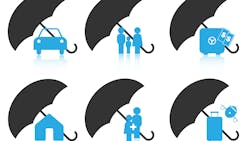Dental insurance: Capitalize on these insurance strategies while you have the time
If there’s one industry that’s still thriving during this economic turmoil, it’s the insurance industry. While most of us have already contacted our creditors to apply for payment deferment or forbearance agreements, my insurance premiums have not stopped, nor will there be any approval for deferment or forbearance. Insurance premium options are very simple during this pandemic: either pay to continue your coverage or stop paying and lose your coverage.
Because those I care for require necessary medicine to stay alive, stopping my coverage is not an option. Oh, and the knee surgeries my wife was supposed to undergo this summer will likely be postponed until later this year, or possibly next year. Needless to say, we won’t be using our insurance fully this year because we won’t have access to surgeons. But, like the rest of those who have medical insurance, we continue to pay those premiums despite being in a state of temporary (I hope!) unemployment or lack of income for the foreseeable future.
As a person who deals with dental insurance for a living, I’d like to report that the dental insurance industry is alive and well, and is happy to see not anywhere near a high volume of claims at this time. In fact, the industry will likely report some of the best profits this year simply because all elective or nonemergent treatments were at a halt during March, April, and most of May. With many dentists returning to work by now, claims are still at an all time low. While it has been said that the insurance industry needs you, the doctors, to survive, I reluctantly report that the industry is doing better than ever as a result of government mandates to shut down practices during the last few months, resulting in fewer insurance benefits to claim.
With the stockpile of cash that insurance companies are now sitting on, here are a few insurance-related strategies I recommend dentists employ today to gain a few more insurance dollars when you get back to work.
Negotiate your insurance fees
For those of you who are contracted providers of dental insurance, it is quite common for PPO fees to be outdated and below usual, customary, and reasonable (UCR) standards. Insurance companies usually reserve the best fee schedules for those who make a concerted and successful effort to negotiate. Mostly, DSOs and professional negotiating firms lead the way in successful insurance fee negotiations. DSOs and professional negotiating firms understand the leverage and relationship dynamics in navigating complex, murky, and often shark-filled negotiating waters in an effort to influence insurance companies to move the “fee needle” in their favor. While most dental practices are not seeing patients at this time, take advantage of the opportunity to contact insurance companies to negotiate your fees. While many dentists will attempt to negotiate on their own, only a handful will see results. This is largely due to a great disadvantage that solo practitioners have when it comes to negotiating, and that’s leverage!
Clean up your insurance accounts receivables
With timely filing laws and guidelines that are still in place, even during mandatory dental practice shutdowns, you only have so many months to attempt to collect insurance payments. Also, most people in the US (and other countries) are still gainfully employed, so collecting copayments and other patient financial responsibilities should still be alive and well. Much like how we had to apply for payment deferment and forbearance on our monthly debts, if patients need help, let them ask. But be prepared to offer them the same courtesy your mortgage company and credit card companies gave you. It goes a long way in helping others financially by postponing payments until a future date; it builds goodwill and is good business. Let those patients reach out and ask you for help as most patients are still earning regular incomes. In short, use this time to bring your receivables current so you can focus on creating demand when you get back to work.
Create your own demand
During the Great Depression, many companies continued to thrive and survive. A common ingredient among the successful businesses was that they had financially lean operations, and they did not assume that all people were unemployed and poor. According to the US Federal Government, the highest unemployment rate was 24.9% in 1933.1 This means that 75% of eligible and able working adults were gainfully employed. The majority were by no means rich, but the majority reported income of some type.
Successful business owners did not allow negative public perception to determine their work output or psychological well-being. No! Instead, they continued to market their products and create demand for their businesses. Through their advertisements they created public perception that people needed products and could afford those products. For instance, many bakers sold “warm and fresh” loaves of bread for 3 to 7 cents. Men’s work shoes were advertised at $1.35, pants for 75 cents, granulated sugar for 85 cents for 10 pounds, a gallon of milk for 75 cents, a dozen eggs for 25 cents, etc.2 Thriving companies engaged in some of the most competitive and creative advertisement wars to showcase how affordable living was at the time.
Businesses that were operational during these times didn’t report their efforts as a “wartime” focus because they were too busy dealing with customers and counting their money. Successful businesses thrived while many competitors allowed negative public perception to lead them to failure. Successful businesses engaged in inexpensive, creative, and consistent advertising to create their demand and tap into the wants and needs of society. Some of the most successful businesses at the time were breweries, not because everyone wanted to drown their sorrows in alcohol, but because the affordability and desire for beer created demand.3 My suggestion for you is to create a membership plan and perhaps waive the membership fee for a few months or even a year. Many employers may cut back on dental insurance subscriptions, so, building a membership plan on your own will capture those who need work and may lose their insurance.
Activate the stockpile of unscheduled treatment: Perform preauthorizations
In dentistry, preauthorizations (preauths) are grossly overlooked. The main concern behind submitting a preauth is the time that it takes to receive a response from insurance. While that is an acceptable response under normal circumstances, being shut down during this pandemic should allow for more consideration of preauths. In our poll of over 2,000 patients, the number one reason why patients delay treatment is due to the unexpected nature of costs. The “estimated out of pocket” is not something most patients are confident in.
We conducted a search for offices that perform preauthorizations at a high rate and we stumbled upon the practice of Thomas Dunham, DDS, in Virginia Beach. His case acceptance is 95%. According to Allan Hollander of ePracticeManager, the national case acceptance is 27%. Melissa Dunham, the business manager for Dr. Dunham’s practice, attributes their rate of case acceptance to the fact that their office performs preauthorization for every major procedure. She said that patients are informed about the total cost of treatment and have a clear picture of what to budget for.
She believes that if offices perform preauthorizations regularly they will naturally see more patients moving forward with treatment, especially patients who need extensive work. She noticed this exact pattern of increased case acceptance when she began submitting for preauthorizations for all major procedures. What Melissa and Dr. Dunham have experienced is largely true for the other practices we interviewed that implemented the same preauth policy. But during a pandemic, you do not have to risk delaying treatment as patients are not able to receive nonemergency care anyway. Submitting preauthorization now for unscheduled treatment going back six to 12 months will allow you to create demand for treatment from patients you’ve already seen. At a time when most dentists are not working, you have nothing to lose in spending some time and using some of those Payroll Protection Program (PPP) dollars to keep your team busy.
As I stated earlier, those who are proactive let their presence be known in their communities are those who have proven to survive economic downturns. While we are not yet in an official recession, implementing the strategies I listed will allow you to prepare for record numbers when you return to work. While the world may look ugly right now, what you do today will determine your success tomorrow. As you continue to work hard and implement these strategies, I promise you years of prosperity ahead!
References
1. Labor Force, Employment, and Unemployment, 1929-39: Estimating Methods 1. Monthly Labor Review. July 1948. https://www.bls.gov/opub/mlr/1948/article/pdf/labor-force-employment-and-unemployment-1929-39-estimating-methods.pdf
2. Williams G. A glimpse at your expenses 100 years ago. US News and World Report. January 2, 2015. https://money.usnews.com/money/personal-finance/articles/2015/01/02/ a-glimpse-at-your-expenses-100-years-ago
3. Vinton K. How breweries like Coors, Yuengling, and Anheuser-Busch survived prohibition. Forbes. November 4, 2015. https://www.forbes.com/sites/katevinton/2015/11/04/how-breweries-like-coors-yuengling-and-anheuser-busch-survived-prohibition/#fe23790fabd1
BENJAMIN TUINEI is the president of Veritas Dental Resources, a company that helps dentists improve insurance reimbursements. He has been recognized by several state dental associations and continuing education institutions as “the authority” on PPO strategies and fee negotiating. He has worked with 6,000-plus dentists and influenced more than $3 billion in negotiated revenue for his clients. To learn more, visit veritasdentalresources.com.
About the Author

Benjamin Tuinei, president of Veritas Dental Resources
Benjamin Tuinei, president of Veritas Dental Resources, works to help dentists improve insurance reimbursements. He has been recognized by several state dental associations and continuing education institutions as “the authority” on PPO strategies and fee negotiating. He has worked with 9,000-plus dentists and influenced more than $5 billion in negotiated revenue for his clients. To learn more, visit veritasdentalresources.com.
